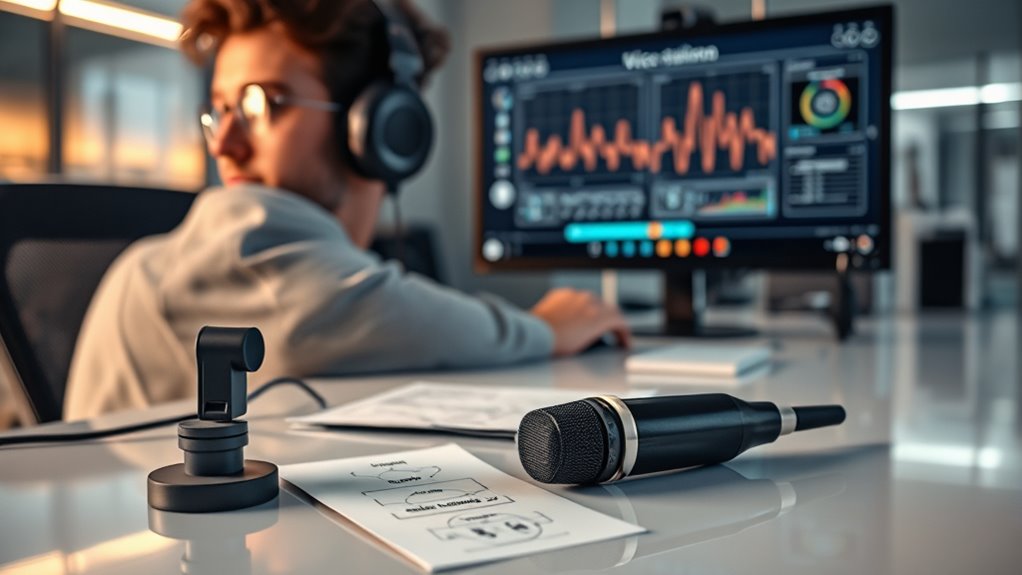In voice-first UX, you face unique QA challenges like ensuring speech recognition works accurately across different accents, environments, and user inputs. You need to test conversational flows for naturalness, personalization, and context understanding, which can be unpredictable. Constant updates and real-world simulations are essential to maintain reliability and user satisfaction. If you keep exploring, you’ll discover how rigorous testing helps create seamless, engaging voice experiences that users trust.
Key Takeaways
- Simulating real-world, unpredictable voice interactions requires extensive testing of varied speech inputs and conversational contexts.
- Ensuring accurate recognition across diverse accents, dialects, and background noises presents significant QA challenges.
- Validating personalization features involves testing user-specific data security, identification, and consistent experience over time.
- Continuous updates and learning from user interactions demand ongoing QA efforts to maintain system reliability and responsiveness.
- Transitioning from static feature testing to dynamic conversational validation emphasizes natural language understanding and contextual accuracy.

Have you ever wondered how voice technology is transforming user experiences? It’s revolutionizing how people interact with devices, making conversations feel more natural and intuitive. At the core of this shift is speech recognition, a technology that allows machines to understand and process spoken language. As you design voice-first user experiences, you realize that speech recognition isn’t just about accurately transcribing words; it’s about capturing context, tone, and intent in real time. When speech recognition functions well, users feel understood and engaged, but even small errors can lead to frustration and disengagement. That’s why rigorous testing becomes vital—ensuring the system reliably interprets diverse accents, speech patterns, and background noise. You need to test not only the accuracy of the transcription but also how well the system adapts to different environments and user inputs.
Effective voice experiences depend on rigorous testing of speech recognition across accents, environments, and speech patterns.
Another significant aspect is user personalization. Voice interfaces thrive on tailoring interactions to individual users, which means your QA process must incorporate scenarios that reflect diverse user profiles. When voice technology is designed with user personalization in mind, it can remember preferences, recognize voices, and adapt responses accordingly. These features enhance user satisfaction but also introduce new complexities in testing. You must verify that personal data remains secure and that the system correctly identifies and responds to each user without confusion. Personalization demands a deep understanding of user context—what someone prefers, their vocabulary, and their typical commands—so your testing must cover a broad range of personalized interactions to ensure consistency and reliability.
The challenge for QA teams is balancing the need for broad coverage with the flexibility of voice interactions. Unlike traditional apps, voice experiences are fluid and unpredictable, often requiring your tests to simulate real-world conversations. You’ll need to validate that speech recognition correctly interprets a range of accents, speech speeds, and colloquialisms, while also confirming that user personalization features respond accurately over time. It’s not just about catching bugs; it’s about understanding how users naturally speak and ensuring the system handles those variations gracefully. This involves continuous testing, updates, and learning from real user interactions to refine the voice experience. Additionally, understanding the state-specific nuances of voice commands can greatly improve the system’s contextual accuracy and user satisfaction.
In essence, testing voice-first UX demands a shift in mindset. You’re no longer just verifying static features; you’re ensuring a dynamic, conversational experience that feels natural and personalized. Speech recognition and user personalization are foundational, but they also introduce complexities that require meticulous, ongoing QA efforts. By embracing these challenges, you help create voice interfaces that are not only accurate and responsive but also genuinely engaging and user-centric.
Frequently Asked Questions
How Does Voice-First UX Impact Accessibility Standards?
You should consider how voice recognition impacts accessibility standards, as it can make technology more inclusive but also introduces new challenges. Ensuring accessibility compliance means designing voice-first UX that accommodates users with different abilities, like those with speech impairments or disabilities. By testing voice recognition thoroughly, you help create a seamless experience for all users and meet accessibility standards, making your product truly accessible and compliant.
What Are the Best Practices for Voice Command Error Recovery?
When handling voice command errors, you should focus on effective error handling and clear user feedback. Always acknowledge the mistake, clarify the correct command, and offer suggestions for next steps. Use natural language to guide users back on track, and guarantee your system responds promptly. This approach minimizes frustration, builds user trust, and creates a seamless experience, even when errors occur.
How to Measure User Satisfaction in Voice-First Interfaces?
Imagine you’re tuning into a symphony where every note reflects user satisfaction. To measure this in voice-first interfaces, you should listen to the subtle cues of emotional analytics and gauge how users react to gesture controls. Collect feedback through surveys, monitor tone and response times, and analyze user interactions. These insights help you understand their experience, turning raw data into a melody of continuous improvement.
What Legal Considerations Are Involved in Voice Data Collection?
When collecting voice data, you should consider legal issues like privacy concerns and data security. You’re responsible for obtaining user consent and clearly explaining how their voice data will be used. Protect this data with strong security measures to prevent breaches. Be aware of regulations such as GDPR or CCPA, which set standards for data privacy, and ensure your voice data collection practices conform to avoid legal risks.
How Can QA Teams Simulate Diverse Voice User Scenarios Effectively?
You can effectively simulate diverse voice user scenarios by creating a wide range of voice command diversity in your testing. Use real user data and synthetic samples to mimic different accents, speech patterns, and environments. Incorporate various user scenarios to identify potential issues. Automate tests where possible, and involve diverse testers to guarantee your voice command system handles all kinds of interactions, improving accuracy and user satisfaction.
Conclusion
As voice-first UX continues to grow, embracing new QA challenges is essential. Did you know that by 2025, over 8 billion voice assistants are expected to be in use worldwide? This highlights the importance of rigorous testing to guarantee seamless interactions. By prioritizing quality assurance now, you can create more reliable, user-friendly voice experiences that meet rising user expectations. Stay ahead by addressing these challenges early and delivering exceptional voice-first solutions.
Randy serves as our Software Quality Assurance Expert, bringing to the table a rich tapestry of industry experiences gathered over 15 years with various renowned tech companies. His deep understanding of the intricate aspects and the evolving challenges in SQA is unparalleled. At EarnQA, Randy’s contributions extend well beyond developing courses; he is a mentor to students and a leader of webinars, sharing valuable insights and hands-on experiences that greatly enhance our educational programs.










